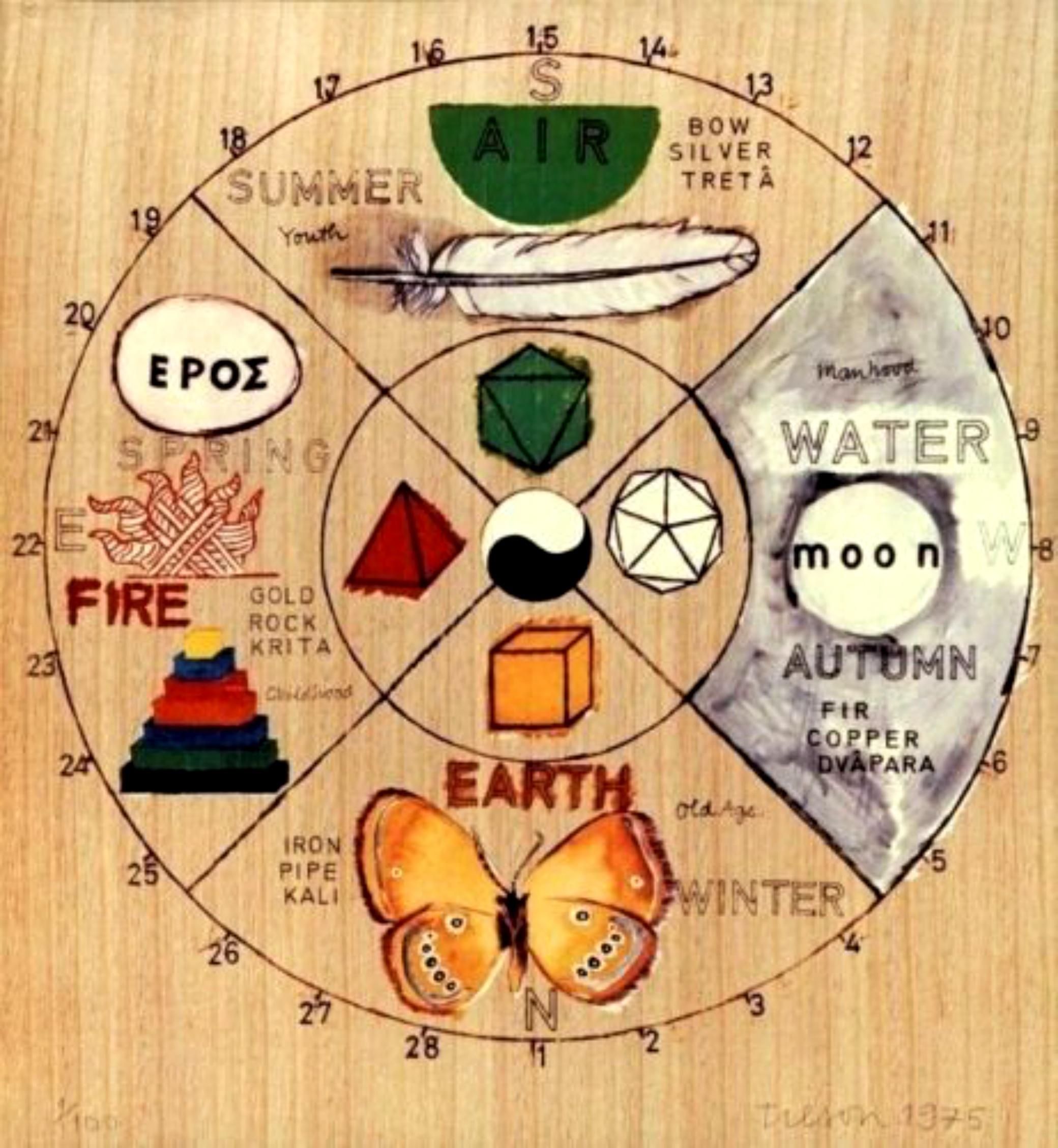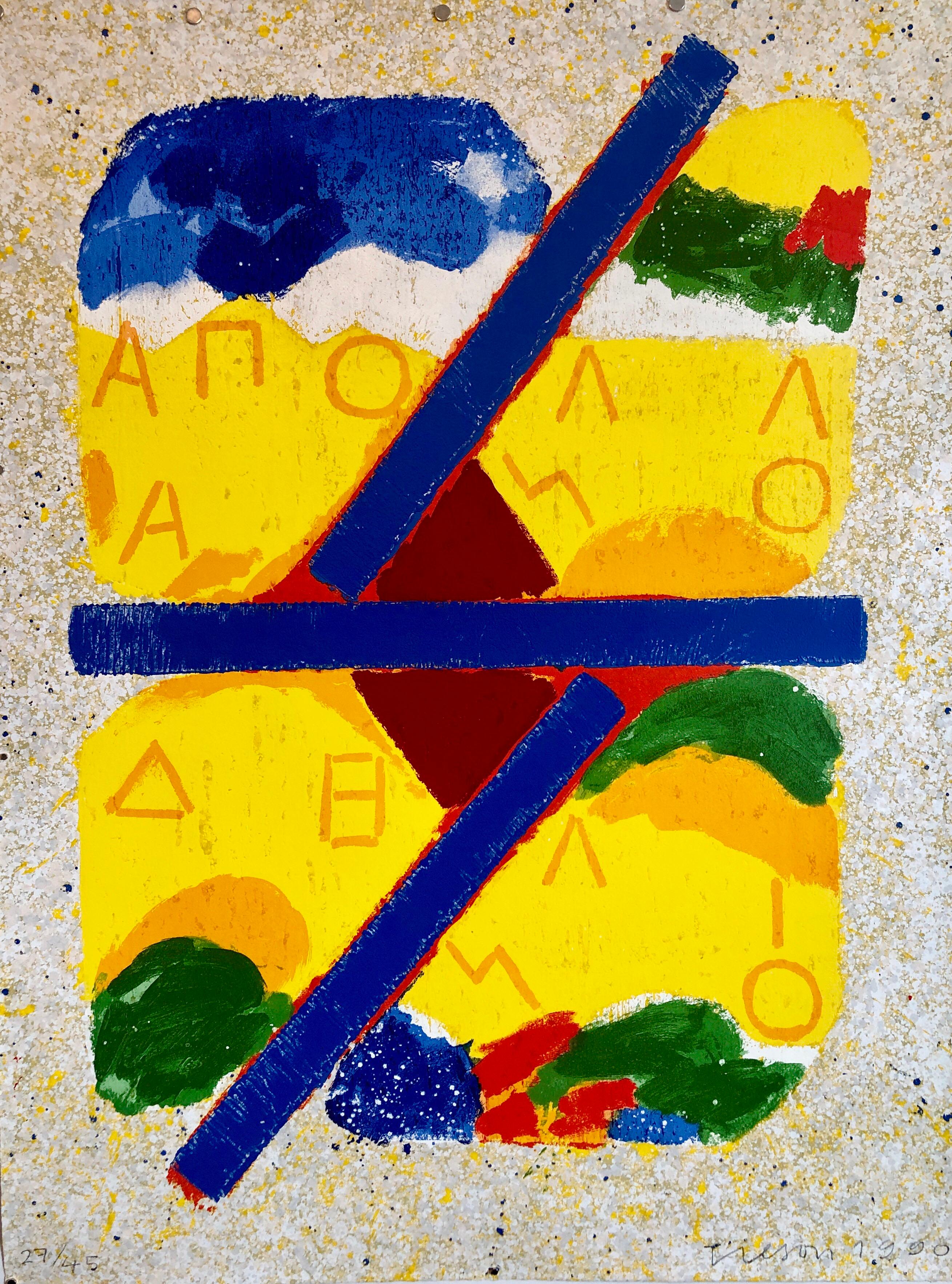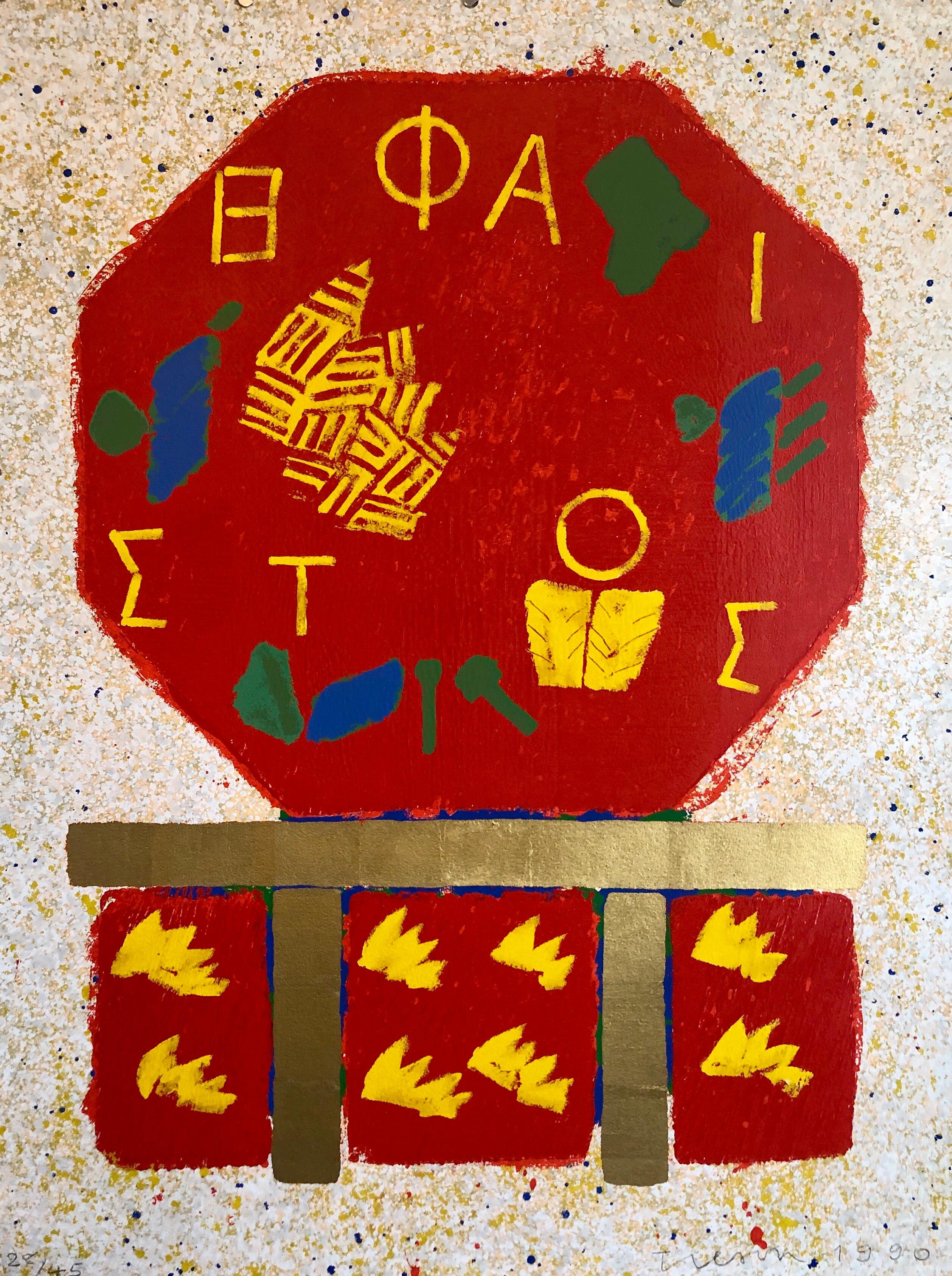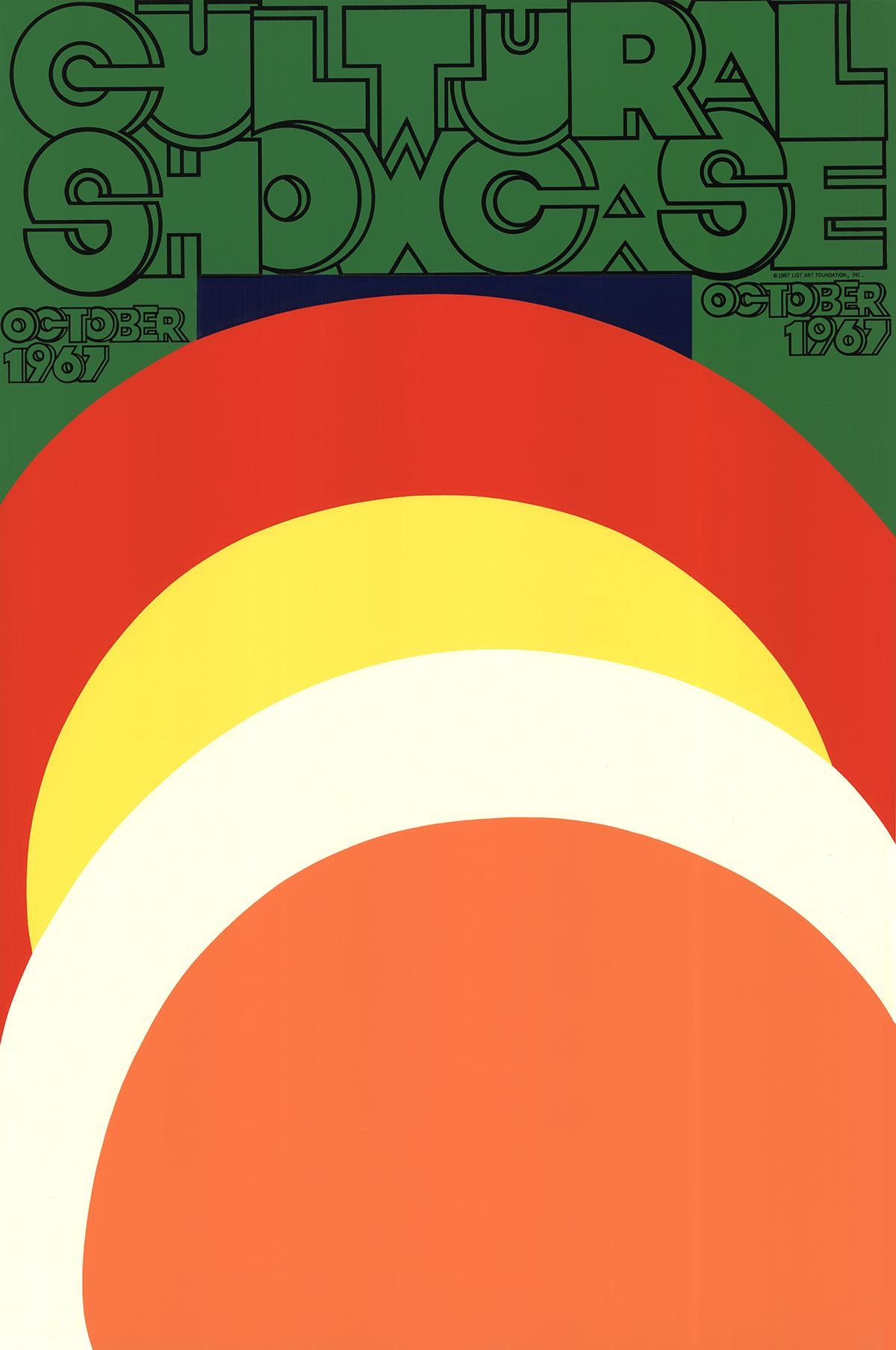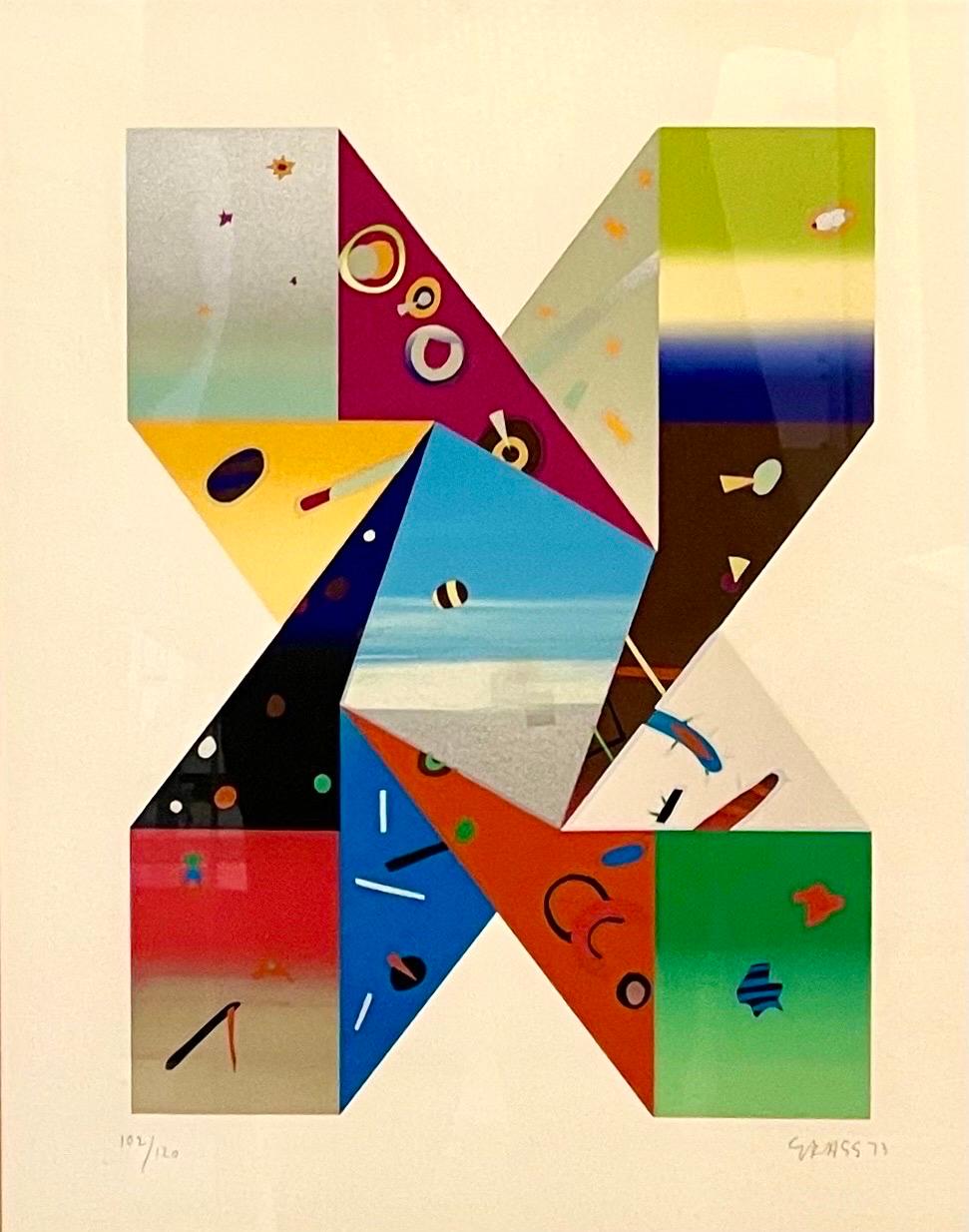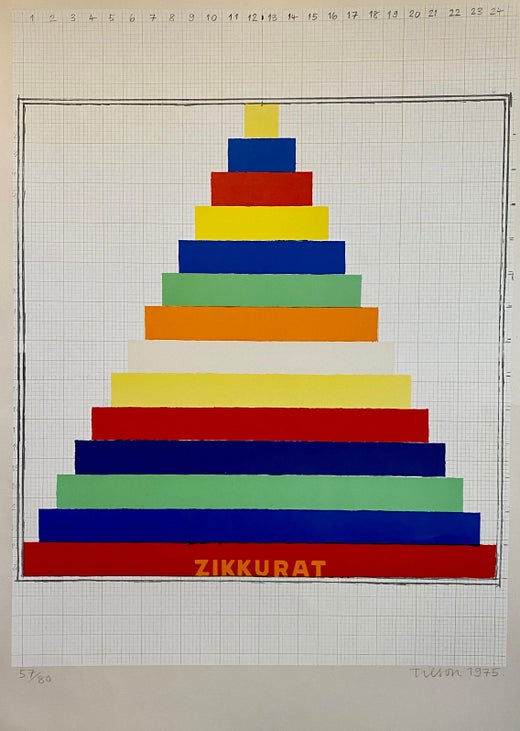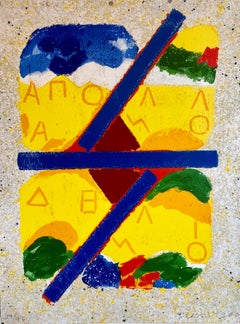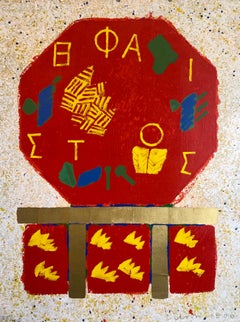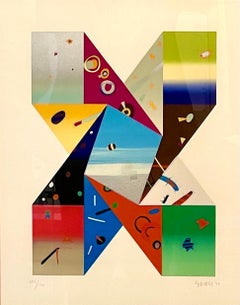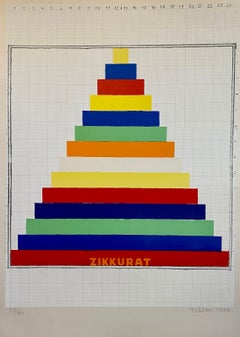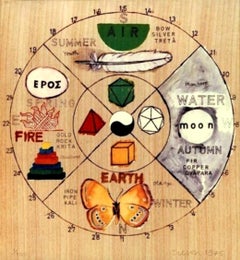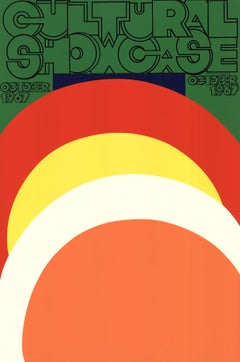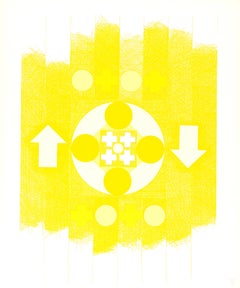Items Similar to Joe Tilson British Pop Art Screenprint, Color Lithograph 4 Seasons 4 Elements
Want more images or videos?
Request additional images or videos from the seller
1 of 16
Joe TilsonJoe Tilson British Pop Art Screenprint, Color Lithograph 4 Seasons 4 Elementsc.1975
c.1975
$1,800
£1,353.46
€1,571.69
CA$2,513.66
A$2,787.84
CHF 1,464.04
MX$34,236.63
NOK 18,533.30
SEK 17,477.15
DKK 11,726.53
Shipping
Retrieving quote...The 1stDibs Promise:
Authenticity Guarantee,
Money-Back Guarantee,
24-Hour Cancellation
About the Item
Silkscreen screenprint or Lithograph
Hand signed and numbered. An esoteric, mystical, Kabbala inspired print with Hebrew as well as other languages.
Joseph Charles Tilson RA (born 24 August 1928 in London) is an English pop art painter, sculptor and printmaker.
Born in 1928, Tilson served in the Royal Air Force (1946–49), after which he studied in London at St Martin's School of Art (1949–52) under Leon Kossoff and Frank Auerbach. He later attended the Royal College of Art in London, where he won the prestigious Rome Prize. The artist represented the United Kingdom in the 32nd Venice Biennale in 1964, which famously included the works of Robert Rauschenberg, Jasper Johns, Claes Oldenburg, and Jim Dine. He returned to London in 1957, and from 1958 to 1963 he taught at St Martin's School of Art, and subsequently taught at the Slade School of Fine Art, University College London and The School of Visual Arts, New York and the Hochschule fur Bildende Künste, Hamburg. In 1961 he exhibited at the Paris Biennale.
During the 1960s Tilson became one of the leading figures associated with the British Pop Art movement. A movement that ran independent of and concurrent to the American pop art of Andy Warhol, Roy Lichtenstein and James Rosenquist. Making use of his previous experience as a carpenter and joiner, Tilson produced wooden reliefs and constructions as well as prints and paintings. As a student at the RCA Tilson associated with Frank Auerbach, Leon Kossoff, R. B. Kitaj, Peter Blake, Allen Jones, Patrick Caulfield and David Hockney.
His first one-man show was held at the Marlborough Gallery, London in 1962. In 1977 he joined the Waddington Galleries and also exhibited at the Alan Cristea Gallery and the Giò Marconi Galleries in Milan. Tilson's work gained an international reputation when shown at the XXXII Venice Biennale in 1964, which led to a retrospective at the Boymans Museum, Rotterdam in 1964. Further retrospective exhibitions followed at the Vancouver Art Gallery in 1979 and the Arnolfini Gallery, Bristol in 1984.
Growing disillusionment with the consumer society led to a change in Tilson work in the 1970s. After moving to Wiltshire in 1972, Tilson began to use a wider variety of materials, including stone, straw and rope in an effort to transcend time and culture by drawing on the motifs of pre-Classical mythology. This body of work was called Alchera.
Tilson's work has been exhibited regularly in solo shows throughout the world: Cortona Centro Culturale Fontanella Borghese, Rome (1990), Plymouth City Museum (1991), Palazzo Pubblico, Siena (1995), Mestna Gallery, Ljubljana (1996) and Galleria Comunale d'Arte, Cesena (2000). Recently a major retrospective was held at the Royal Academy of Arts, London (2002). Among Tilson's awards are the Gulbenkian Foundation Prize (1960) and the Grand Prix d'Honneur, Biennale of Ljubljana (1996). He is a Royal Academician and his career was celebrated with a retrospective exhibition in 2002 at the Royal Academy 'Joe Tilson: Pop to Present' (Sackler Galleries) from April 2002. Invited to paint the banner for the "Palio", Siena in 1996
He is represented by Marlborough Fine Art, London and Alan Cristea Gallery, London. He was elected an Associate of the Royal Academy (ARA) in 1985 and a full Royal Academician (RA) in 1991.His work is amongst the finest of modern British printmaking alongside richard smith, alan davie, terry frost, and howard hodgkin.
Tilson's solo exhibitions include:
2013 Marlborough Fine Art, London. Joe Tilson : A Survey
2012–13 University of Ljubljana
2012 Bugno Art Gallery, Venice
2009 Alan Cristea Gallery, London
2008 Bugno Art Gallery, Venice
2007 Waddington Galleries, London
2006 Palazzo Doria, Loano (retrospective)
Menhir Arte Contemporanea, La Spezia
2004 Beaux Arts Gallery, London
2002 Royal Academy of Arts, London (retrospective)
Alan Cristea Gallery, London (prints)
Beaux Arts Gallery, London
2001 Castelbasso, Abruzzo (retrospective)
Giò Marconi Gallery, Milan (retrospective)
1999–2000 Palazzo Pubblico, Siena, touring to Galleria Comunale d'Arte, Cesena and Pinacoteca Civica, Follonica
1999 Peter Guyther Gallery, London
Theo Waddington, Boca Raton, Florida
Castello Doria, Portovenere
1998 Theo Waddington Fine Art, London
Marino alla Scala, Milan
1997 Cankarjev Dom, Ljubljana (prints retrospective)
1996 Annandale Galleries, Sydney
Mestna Gallery, Ljubljana
1995 Westend Galerie, Frankfurt
Palazzo Pubblico, Siena
Theo Waddington Fine Art, London
Alan Cristea Gallery, London
1994 Pinacoteca, Macerata
Galleria Rotta, Genova
1993 Multimedia, Brescia
Giò Marconi, Milan
Cooperativa Ceramica d'Imola
Heter A Hunermann Galerie GmbH, Düsseldorf
1992 Extra Moenia, Todi
Waddington Graphics, London
Waddington Galleries, London
1991 Plymouth City Museum
Tour Fromage, Aosta
Galerie Inge Baecker, Cologne
1990 Centro Culturale Fontanella Borghese, Rome
Fortezza Medicea, Cortona
1984 Arnolfini Gallery, Bristol (retrospective)
1979 Vancouver Art Gallery (prints retrospective)
1978 Tate Gallery, London (prints)
1976 Marlborough Fine Art, Marlborough Graphics, London
1971 Museum Boijmans van Beuningen, Rotterdam (retrospective) touring to Belgium and Italy
Waddington Galleries, London
1970 Marlborough New London Gallery, London
1968 Galleria Ferrari, Verona
Galleria de Foscherari, Bologna
Galerie Brusberg, Hanover
1967 Galleria del Naviglio, Milan
Marlborough Galleria d'Arte, Rome
1966 Marlborough New London Gallery, London
1965 Kunstamt Reinickendorf, Berlin
Stadt Museum, Recklinghausen
Kunstverein, Braunschweig
Stedelijk Museum, Amsterdam
1964 Marlborough New London Gallery, London
British Pavilion, XXXII Venice Biennale
Modern Galerija, Zagreb
1963 Hatton Gallery, Newcastle upon Tyne
Ferens Art Gallery, Hull
Walker Art Gallery, Liverpool
University Art Gallery, Nottingham
1962 Marlborough New London Gallery
Public collections
Tilson's art is held in collections internationally including the Tate Gallery, London; MoMA, New York and the Stedelijk, Amsterdam.
Arts Council England, London
Boijmans van Beuningen Museum, Rotterdam
British Council, London
British Library, London
Galleria Nazionale d'Arte Moderna, Rome
Kunsthalle, Basel
Kunstmuseum, Hannover
Museo de Arte, São Paulo
Museu de Arte Moderna, Sintra
Museum of Art, Carnegie Institute, Pittsburgh
Museum of Contemporary Art, Tehran
Museum of Modern Art, New York
Peter Stuyvesant Foundation, Amsterdam
South African National Gallery, Cape Town
Stedelijk Museum, Amsterdam
Tate, London
Victoria & Albert Museum, London
Walker Art Gallery, Liverpool
Yale Center for British Art, New Haven
- Creator:Joe Tilson (1928, British)
- Creation Year:c.1975
- Dimensions:Height: 39 in (99.06 cm)Width: 27.5 in (69.85 cm)
- Medium:
- Movement & Style:
- Period:
- Condition:good. minor wear. creasing lower right corner. please see photos. should mat out OK,.
- Gallery Location:Surfside, FL
- Reference Number:1stDibs: LU38211765782
Joe Tilson
Joe Tilson (1928 – Present) Tilson was born on 24th August, 1928 in London, England. Tilson served in the Royal Air Force from 1946 – 49, after which he studied at St Martin’s School of Art (1949-1952) and the Royal College of Art (1952 – 1955). He won the Rome Prize for graduation, taking him to Italy from 1955 - 1957. From 1958 – 1963, Tilson taught at St Martin’s School of Art, the Slade School of Fine Art, University College London and the School of Visual Arts, New York. During the 1960s, Tilson’s artistic career took off as he attracted attention for his unique wooden reliefs and constructions, prints and paintings in the emerging British Pop Art style. He held his first solo exhibition at the Marlborough Galley, London in 1962. In 1977, Tilson joined the Waddington Galleries, exhibited at the Alan Cristea Gallery and the Giò Marconi Galleries in Milan. At the Venice Biennale in 1964, Tilson’s work began to gain international popularity, earning him a retrospective at the Boyman’s Museum, Rotterdam later that year. Growing anti-consumerist feeling in the 1970s pushed Tilson to begin to incorporate a wider variety of materials in his work, including stone, straw and rope to create a timeless feel to his work. This body of work was called Alchera, and was a huge success. Tilson was made a Royal Academician in 2002 which was celebrated with a retrospective exhibition in the same year at the Royal Academy entitled Joe Tilson: Pop to Present. Tilson is collected internationally, including at the Arts Council England, London; the British Library, London; Christchurch College, Oxford; the Ludwig Múzeum, Budapest; the Tate, London; Royal Academy of Arts, London; Scottish National Gallery of Modern Art, Edinburgh; The Royal Collection; Victoria and Albert Museum, London; Museum of Modern Art (MoMA), New York and the Yale Centre for British Art, New Haven
About the Seller
4.9
Platinum Seller
Premium sellers with a 4.7+ rating and 24-hour response times
Established in 1995
1stDibs seller since 2014
1,778 sales on 1stDibs
Typical response time: <1 hour
- ShippingRetrieving quote...Shipping from: Surfside, FL
- Return Policy
Authenticity Guarantee
In the unlikely event there’s an issue with an item’s authenticity, contact us within 1 year for a full refund. DetailsMoney-Back Guarantee
If your item is not as described, is damaged in transit, or does not arrive, contact us within 7 days for a full refund. Details24-Hour Cancellation
You have a 24-hour grace period in which to reconsider your purchase, with no questions asked.Vetted Professional Sellers
Our world-class sellers must adhere to strict standards for service and quality, maintaining the integrity of our listings.Price-Match Guarantee
If you find that a seller listed the same item for a lower price elsewhere, we’ll match it.Trusted Global Delivery
Our best-in-class carrier network provides specialized shipping options worldwide, including custom delivery.More From This Seller
View AllVibrant Joe Tilson British Pop Art Screenprint, Woodblock, Colorful Print
By Joe Tilson
Located in Surfside, FL
Silkscreen screenprint with woodblock and silver leaf Hand signed and numbered. In vibrant color of blue and silver on heavy paper with an almost painting type texture to it.
Josep...
Category
1990s Pop Art Abstract Prints
Materials
Screen
Joe Tilson British Pop Art Screenprint, Woodblock, Gold Leaf Print
By Joe Tilson
Located in Surfside, FL
Silkscreen screenprint with woodblock and gold leaf Hand signed and numbered.
Joseph Charles Tilson RA (born 24 August 1928 in London) is an English pop art painter, sculptor and pr...
Category
1990s Pop Art Abstract Prints
Materials
Screen
Deborah Kass Feminist Jewish American Pop Art Silkscreen Screenprint Ltd Edition
By Deborah Kass
Located in Surfside, FL
Deborah Kass (born 1952)
Limited edition geometric abstract lithograph in colors on artist paper.
Hand signed and dated in pencil to lower right. 1973.
Edition: 102/120 to lower left.
Dimensions: sight: 16-3/4" W x 21-1/4" H. Frame: 24-5/8" W x 28-7/8" H.
Finding inspiration in pop culture, political realities, film, Yiddish, art historical styles, and prominent art world figures, Deborah Kass uses appropriation in her work to explore notions of identity, politics, and her own cultural interests. She received her BFA in painting at Carnegie Mellon University and studied at the Whitney Museum Independent Study Program and the Art Students League of New York.
Deborah Kass (born 1952) is an American artist whose work explores the intersection of pop culture, art history, and the construction of self. Deborah Kass works in mixed media, and is most recognized for her paintings, prints, photography, sculptures and neon lighting installations. Kass's early work mimics and reworks signature styles of iconic male artists of the 20th century including Frank Stella, Andy Warhol, Jackson Pollock, and Ed Ruscha. Kass's technique of appropriation is a critical commentary on the intersection of social power relations, identity politics, and the historically dominant position of male artists in the art world.
Deborah Kass was born in 1952 in San Antonio, Texas. Her grandparents were from Belarus and Ukraine, first generation Jewish immigrants to New York. Kass's parents were from the Bronx and Queens, New York. Her father did two years in the U.S. Air Force on base in San Antonio until the family returned to the suburbs of Long Island, New York, where Kass grew up. Kass’s mother was a substitute teacher at the Rockville Centre public schools and her father was a dentist and amateur jazz musician.
At age 14, Kass began taking drawing classes at The Art Students League in New York City which she funded with money she made babysitting. In the afternoons, she would go to theater on and off Broadway, often sneaking for the second act. During her high school years, she would take her time in the city to visit the Museum of Modern Art, where she would be exposed to the works of post-war artists like Frank Stella and Willem De Kooning. At age 17, Stella’s retrospective exhibition inspired Kass to become an artist as she observed and understood the logic in his progression of works and the motivation behind his creative decisions.
Kass received her BFA in Painting at Carnegie Mellon University (the alma mater of artist Andy Warhol), and studied at the Whitney Museum Independent Study Program Here, she created her first work of appropriation, Ophelia’s Death After Delacroix, a six by eight foot rendition of a small sketch by the French Romantic artist, Eugène Delacroix.
At the same time Neo-Expressionism was being helmed by white men in the late Reagan years, women were just beginning to create a stake in the game for critical works. “The Photo Girls...
Category
2010s Pop Art Figurative Prints
Materials
Screen
Vibrant 1975 Joe Tilson British Pop Art Screenprint, Woodblock, Colorful Print
By Joe Tilson
Located in Surfside, FL
Silkscreen screenprint. Hand signed and numbered. A pyramid or ziggurat in vibrant colors of blue, red, yellow, orange and green on heavy paper
Joseph Charles Tilson RA (born 24 Au...
Category
1970s Pop Art Abstract Prints
Materials
Screen
Hungarian Surrealism Pop Art Hebrew Silkscreen Judaica Print Jewish Serigraph
By Jozsef Jakovits
Located in Surfside, FL
Abstract Hebrew Prints on heavy mould made paper from small edition of 15. there is a facing page of text in Hungarian folded over. Hard edged geometric abstract prints in color base...
Category
1980s Pop Art Abstract Prints
Materials
Archival Paper, Screen
Surrealist Abstract Hebrew Shabbat Pop Art Silkscreen Judaica Jewish Serigraph
By Jozsef Jakovits
Located in Surfside, FL
Abstract Hebrew Prints on heavy mould made paper from small edition of 15. there is a facing page of text in Hungarian folded over. Hard edged geometric abstract prints in color base...
Category
1980s Pop Art Abstract Prints
Materials
Archival Paper, Screen
You May Also Like
Mnemonic Device, Silkscreen with hand coloring, Signed/N British Pop Art pioneer
By Joe Tilson
Located in New York, NY
Joe Tilson
Mnemonic Device, 1975
Silkscreen with hand coloring on Thin Bamboo Wood Sheet
21 1/4 × 19 1/2 inches
Edition 96/100
Hand signed and numbered from an edition of 100 on rect...
Category
1970s Pop Art Abstract Prints
Materials
Screen, Ink
After Carol Summers-Cultural Showcase-Serigraph-1967 ORIGINAL
By Carol Summers
Located in Brooklyn, NY
First release exhibition poster by Caroil Summers published by LIST ART in 1967 for the Cultural Showcase. The silk-screen has creases throughout. Blind stamped in the lower left cor...
Category
20th Century Pop Art Prints and Multiples
Materials
Screen
$280 Sale Price
20% Off
Tantra Abstractions, Pop Art Serigraph by John Grillo
By John Grillo
Located in Long Island City, NY
Artist: John Grillo, American (1917 - 2014)
Title: Tantra Abstractions
Year: 1980
Medium: Serigraph, signed and numbered in pencil
Edition: 200, AP 30
Image Size: 30 x 22 inches...
Category
1980s Pop Art Abstract Prints
Materials
Screen
Composition, X + X, Ten Works by Ten Painters, George Earl Ortman
By George Earl Ortman
Located in Auburn Hills, MI
Silkscreen on Mohawk Superfine Bristol paper. Inscription: unsigned and unnumbered, as issued. Good condition. Notes: From the folio, X + X, Ten Works by Ten Painters, 1964. Publishe...
Category
1960s Pop Art Landscape Prints
Materials
Screen
$1,996 Sale Price
20% Off
Free Shipping
Odyssetron I (From the suite of 5 lithographs)
Located in San Francisco, CA
This artwork titled "Odyssetron I" 1982 is an original color lithograph by American PopArt artist Bryan Rogers, 1941-2013. It is hand signed and numbered 1/50 in pencil by the artist. With the blind stamp of the publisher, Western Wedge, Oakland California at the lower left corner. The sheet size is 18 x 24 inches. It is in excellent condition, has never been framed. An example of this particular artwork is in the permanent collection of the Museum Of Modern Art in San Francisco...
Category
Late 20th Century Pop Art More Prints
Materials
Lithograph
Liknon - Green, Pop Art Silkscreen by Joe Tilson
By Joe Tilson
Located in Long Island City, NY
Liknon Green
Joe Tilson, British (1928)
Date: 1989
Screenprint, signed and numbered in pencil
Edition of AP 2/5
Size: 39 in. x 40 in. (99.06 cm x 101.6 cm)
Category
1980s Pop Art Abstract Prints
Materials
Screen
